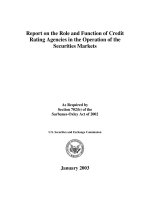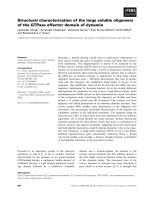The Simple Dollar Elements of Investing_3 potx
Bạn đang xem bản rút gọn của tài liệu. Xem và tải ngay bản đầy đủ của tài liệu tại đây (260.44 KB, 18 trang )
49
Index
insist that you not do it. Your odds of success are at least
better in the stock market than at the racetrack or gambling
casino, and investing in individual stocks can be a lot of
fun. But we do advise you to keep your serious retire-
ment money in index funds. Do what professional inves-
tors increasingly do: Index the core of your portfolio and
then, if you must, make individual bets around the edges.
But have the major core of your investment — and espe-
cially your retirement funds — in a well - diversifi ed set of
stock and bond index funds. You can then “ play the mar-
ket ” with any extra funds you have with far less risk that
you will undermine your chances for a comfortable and
worry - free retirement.
CONFESSION
Nobody ’ s perfect. We certainly aren ’ t. For example, one
of us has a major commitment to the stock of a sin-
gle company — an unusual company called Berkshire
Hathaway. He has owned it for 35 years and has no inten-
tion to sell. If that ’ s bad enough, ponder this: He checks the
price almost every day! Of course, it ’ s nuts — and he knows
it, but just can ’ t help himself. Another example: The other
c02.indd 49c02.indd 49 10/31/09 1:35:13 PM10/31/09 1:35:13 PM
50
The Elements of Investing
author delights in buying individual stocks and has a
signifi cant commitment to China. He enjoys the game
of trying to pick winners and believes “ China ” is a major
story for his grandchildren. ( Please note, in both cases,
our retirement funds are safely indexed — and our chil-
dren use index funds too!)
c02.indd 50c02.indd 50 10/31/09 1:35:13 PM10/31/09 1:35:13 PM
51
III
DIVERSIFY
A very sad story illustrates the crucial need for inves-
tors to diversify their investment holdings. It concerns a
secretary who worked for the Enron Corporation during
its heyday in the late 1990s and early 2000s. Enron was
one of the new - age companies that formed to revolution-
ize the market for electric power and mass communica-
tions. Two charismatic masterminds, Kenneth Lay and
Jeff Skilling, ran Enron and were regularly lionized by
the press for their skill and daring. Enron stock was the
c03.indd 51c03.indd 51 11/3/09 9:41:48 AM11/3/09 9:41:48 AM
52
The Elements of Investing
darling of Wall Street, and it seemed to defy gravity by
rising steadily into the stratosphere.
Like most major companies, Enron had established a
401(k) retirement plan for its employees, offering a range
of options for the regular savings contributions that would
be automatically deducted in each pay period. One of the
investment options in the plan was to put those contribu-
tions into Enron stock. The chief executive offi cer, Ken
Lay, strongly recommended that employees use Enron
stock as their preferred retirement vehicle. Enron was
likened to Elvis Presley revolutionizing the music scene.
The old power companies were like old fogies dancing
to the music of Lawrence Welk. And so the secretary put
all of her retirement savings into Enron stock, and how
glad she was that she did. As the stock soared, while she
had never earned more than a modest secretary ’ s pay, her
retirement kitty was worth almost $3 million. During the
next year, she looked forward to retirement and a life of
leisure and world travel.
Well, she got her wish for more “leisure.” As we now
know, Enron had been built on a mosaic of phony
accounting and fraudulent trading schemes. Jeff Skilling
went to jail, and Ken Lay died while awaiting trial. The
stock price collapsed, and the secretary ’ s entire retirement
c03.indd 52c03.indd 52 11/3/09 9:41:48 AM11/3/09 9:41:48 AM
53
Diversify
kitty vaporized. She lost not only her job, but also her
life savings. She had made the mistake of putting all
her investments in one basket. Not only did she fail to
diversify her investments, but she put herself in double
jeopardy because she took exactly the same risks with her
portfolio as she did with her income from employment.
She failed to heed one of the few absolute rules of invest-
ing: Diversify, Diversify, Diversify.
James Rhodes spent his entire career in the automobile
industry casting iron dies that turned sheet metal into
fenders, hoods, and roofs. When he left the business, he
and his wife decided that they could securely invest their
entire accumulated savings in Chrysler bonds, paying
an attractive 8 percent interest rate per year. They, like
so many autoworkers, had faith in the iconic big three
automakers ’ ability to survive even in the worst economic
times. And the generous interest payments allowed them
to continue to enjoy a comfortable middle-class lifestyle —
for a while. Now the Rhodeses ’ faith in the auto industry
and their retirement savings have evaporated. Many indi-
vidual investors lost almost everything as the bankruptcy
of Chrysler and General Motors left the secured bond-
holders with no continuing interest payments and only a
minimal equity stake in the bankrupt companies.
c03.indd 53c03.indd 53 11/3/09 9:41:48 AM11/3/09 9:41:48 AM
54
The Elements of Investing
These very sad stories make all too clear the cardinal
rule of investing: Broad diversifi cation is essential.
Enron, Chrysler, and General Motors are not isolated
examples. Surprisingly, many large and seemingly stable
industrial companies have gone belly up. Even large fi nan-
cial institutions — banks such as Wachovia, investment
fi rms such as Lehman Brothers, insurance companies such
as AIG — have gone bankrupt or were forced into merg-
ers or government trusteeship after the value of their stocks
cratered. And many fi nancial executives, who should have
known better, were wiped out because they had all of their
assets invested in the fi rms where they worked because they
felt loyalty and confi dence in “ their ” company. If we had
our way, no employee contributions to a 401(k) plan could
be invested in their own company. Protect yourself: Every
investor should always diversify.
Protect yourself: Every investor
should always diversify.
DIVERSIFY ACROSS ASSET CLASSES
What does diversifi cation mean in practice? It means that
when you invest in the stock market, you want a broadly
diversifi ed portfolio holding hundreds of stocks. For people
c03.indd 54c03.indd 54 11/3/09 9:41:48 AM11/3/09 9:41:48 AM
55
Diversify
of modest means, and even quite wealthy people, the way
to accomplish that is to buy one or more low - cost equity
index mutual funds. The fund pools the money from
thousands of investors and buys a portfolio of hundreds
of individual common stocks. The mutual fund collects
all the dividends, does all the accounting, and lets mutual
fund owners reinvest all cash distributions in more shares
of the fund if they so wish.
While some mutual funds are specialized, concentrating
in a particular market segment such as biotechnology com-
panies or Chinese companies, we recommend that the fund
you choose have a mandate of broad diversifi cation and
hold securities in a wide spectrum of companies spanning
all the major industries. We will give you tips in Chapter 5
on how to select the best, lowest - cost, and most diversifi ed
investment funds available.
Diversify across securities, across asset classes,
across markets — and across time.
By holding a wide variety of company stocks, the inves-
tor tends to reduce risk because most economic events do
not affect all companies the same way. A favorable event
such as the approval of a new pharmaceutical could be a
major boost for the company that discovered the drug.
c03.indd 55c03.indd 55 11/3/09 9:41:48 AM11/3/09 9:41:48 AM
56
The Elements of Investing
At the same time, it could be damaging to companies
making older competing products. Even deep recessions
will have different effects on companies catering to differ-
ent demographic groups. As people tightened their belts
in 2009, they bought less from Tiffany ’ s and more from
Wal - Mart.
Just as you need to diversify by holding a large num-
ber of individual stocks in different industries to moder-
ate your investment risk, so you also need to diversify
by holding different asset classes. One asset class that
belongs in most portfolios is bonds. Bonds are basically
IOUs issued by corporations and government units. (The
government units might be foreign, state and local, or
government - sponsored enterprises such as the Federal
National Mortgage Association, popularly known as
Fannie Mae.) And just as you should diversify by holding
a broadly diversifi ed stock fund, so should you hold a
broadly diversifi ed bond fund.
The U.S. Treasury issues large amounts of bonds. These
issues are considered the safest of all and these bonds are
the one type of security where diversifi cation is not essen-
tial. Unlike common stocks, whose dividends and earn-
ings fluctuate with the ups and downs of the company ’ s
business, bonds pay a fi xed dollar amount of interest.
c03.indd 56c03.indd 56 11/3/09 9:41:48 AM11/3/09 9:41:48 AM
57
Diversify
If the U.S. Treasury offers a $ 1,000 20 - year, 5 percent
bond, that bond will pay $ 50 per year until it matures,
when the principal will be repaid. Corporate bonds are less
safe, but widely diversifi ed bond portfolios have provided
reasonably stable interest returns over time.
High - quality bonds can moderate the risk of a common
stock portfolio by providing offsetting variations to the
inevitable ups and downs of the stock market. For exam-
ple, in 2008, common stock prices fell in both U.S. and
foreign markets as investors correctly anticipated a severe
world - wide recession. But a U.S. Treasury bond portfolio
rose in price as the monetary authorities lowered interest
rates to stimulate the economy. If you are confused about
how bond prices change as interest rates rise and fall, just
remember the “ see - saw ” rule: When interest rates fall, bond
prices rise. When interest rates rise, bond prices fall.
Other asset classes can reduce risk as well. In 2008,
all stock markets around the world fell together. There
was no place to hide. But during most years, while some
national markets zig, others zag. For example, during
2009, when all the major industrial countries were sink-
ing into a deep recession, countries such as China, which
was developing its vast central and western regions, con-
tinued to grow.
c03.indd 57c03.indd 57 11/3/09 9:41:48 AM11/3/09 9:41:48 AM
58
The Elements of Investing
During infl ationary periods, real estate and real assets
such as timber and oil have usually provided better infl a-
tion hedges than ordinary industrial companies whose
profi t margins are likely to get squeezed when raw mate-
rial prices rise. Hence, real estate and commodities have
proven to be useful diversifi ers in many periods. Gold
and gold-mining companies have often had a unique
role as the commodity of choice for diversifi cation.
Gold has historically been the asset to which investors
have fl ed during uncertain and perilous times. It is often
called the hedge against Armageddon.
If you purchase the very broad - based index funds we
list later in this book, you will achieve some of the ben-
efi ts of direct real estate and commodities investing. So -
called “ total stock market ” funds will include both real
estate companies and commodity products. Broad equity
diversifi cation can be achieved with one - stop shopping.
DIVERSIFY ACROSS MARKETS
The stocks of companies in foreign markets such as Europe
and Asia also can provide diversifi cation benefi ts. To be
sure, there is some truth to the expression that when the
United States catches a cold, the rest of the developed world
c03.indd 58c03.indd 58 11/3/09 9:41:48 AM11/3/09 9:41:48 AM
59
Diversify
catches pneumonia; the market meltdowns and painful
recessions of 2008 – 2009 were world - wide. But that does
not mean that economic activity and stock markets in dif-
ferent developed nations always move in lockstep. During
the 1990s, when the U.S. economy was booming, Japan ’ s
economy stagnated for the entire decade. During periods
in the 2000s when the U.S. dollar was falling, the euro
was rising, giving an added boost to European stocks. And
even though globalization has linked our economies more
and more closely, there is still good reason not to restrict
your holding to U.S. stocks. To the extent that you hold
automobile stocks in your portfolio, you should not limit
yourself to Detroit. You are likely to be better off including
Toyota and Honda in a diversifi ed portfolio.
Does achieving extremely broad diversifi cation seem
completely out of reach for ordinary investors? Fear not.
There are broadly invested, very low - cost funds that
can provide one - stop shopping solutions. We will rec-
ommend a broadly diversifi ed United States total stock
market index fund that includes real estate companies
and commodity producers, including gold miners. We
will also show you how a non - U.S. total stock market
fund can give you exposure to the entire world economy,
including the fast-growing emerging markets. Similarly,
c03.indd 59c03.indd 59 11/3/09 9:41:48 AM11/3/09 9:41:48 AM
60
The Elements of Investing
a total bond market fund will allow you to access a fully
diversifi ed bond portfolio. If you will follow the diversi-
fi cation principle here, we will show you, in Chapter 5 ,
the specifi c funds that will allow you to put together a
well - diversifi ed portfolio at low cost.
DIVERSIFY OVER TIME
There is one fi nal diversifi cation lesson that we need
to stress. You should diversify over time. Don ’ t make all
your investments at a single time. If you did, you might
be unlucky enough to have put all of your money into
the stock market during a market peak in early 2000.
An investor who put everything in the market at the
start of 2000 would have experienced a negative return
over the entire decade. The 1970s were just as bad. And
an investor who put everything in at the 1929 peak, like
the father of one of the authors, would not have broken
even for more than 20 years.
You can reduce risk by building up your invest-
ments slowly with regular, periodic investments over
time. Investing regular amounts monthly or quarterly
will ensure that you put some of your money to work
during favorable periods, when prices are relatively low.
c03.indd 60c03.indd 60 11/3/09 9:41:48 AM11/3/09 9:41:48 AM
61
Diversify
Investment advisers call this technique “ dollar cost aver-
aging. ” With equal dollar investments over time, the
investor buys fewer shares when prices are high and more
shares when prices are low. It won ’ t eliminate risk but it
will ensure that you don ’ t buy your entire portfolio at
temporarily infl ated prices. The experience of putting
your entire investment in the stock market at a wrong
time could sour you on common stocks for an entire
lifetime, sadly compounding the problem.
With dollar cost averaging, investors can actually come
out better in a market where prices are volatile and end up
exactly where they started than in a market where prices
rise steadily year after year. Suppose that all investments
are made in a broad stock market index fund and that
$ 1,000 is invested each year over a fi ve - year period. Now
let ’ s consider two scenarios: In the fi rst scenario, the stock
market is very volatile, declining sharply after the pro-
gram is commenced and ending exactly where it started.
In the second scenario, the stock market rises each year
after the program begins. Before we look at the numbers,
ask yourself under which scenario the investor is likely
to do better. We bet that almost everybody would expect to
have better investment results in the situation when the
market goes straight up. Now let ’ s look at the numbers.
c03.indd 61c03.indd 61 11/3/09 9:41:48 AM11/3/09 9:41:48 AM
62
The Elements of Investing
The table on page 63 assumes that $ 1,000 is invested
each year. In scenario one, the market falls immedi-
ately after the investment program begins; then it rises
sharply and fi nally falls again, ending, in year fi ve, exactly
where it began. In scenario two, the market rises con-
tinuously and ends up 40 percent higher at the end of
the period. While a total of exactly $ 5,000 is invested
in both cases, the investor in the volatile market ends
up with $ 6,048 — a nice return of $ 1,048 — even though
the stock market ended exactly where it started. In the
scenario where the market rose each year and ended up
40 percent from where it began, the investor ’ s fi nal stake
is only $ 5,915.
Warren Buffett presents a lucid rationale for the invest-
ment principle illustrated above. In one of his published
essays he says:
A short quiz: If you plan to eat hamburgers
throughout your life and are not a cattle pro-
ducer, should you wish for higher or lower prices
for beef? Likewise, if you are going to buy a car
from time to time but are not an auto manufac-
turer, should you prefer higher or lower car prices?
These questions, of course, answer themselves.
c03.indd 62c03.indd 62 11/3/09 9:41:48 AM11/3/09 9:41:48 AM
63
Diversify
Dollar Cost Averaging
Volatile Flat Market Rising Market
Year
Amount
Invested
Price of
Index
Fund
Number
of Shares
Purchased
Amount
Invested
Price of
Index
Fund
Number
of Shares
Purchased
1 $1,000 $100 10 $1,000 $100 10
2 $1,000 $60 16.67 $1,000 $110 9.09
3 $1,000 $60 16.67 $1,000 $120 8.33
4 $1,000 $140 7.14 $1,000 $130 7.69
5 $1,000 $100 10 $1,000 $140 7.14
Amount invested $5,000 $5,000
Total shares
purchased
60.48 42.25
Average cost of
shares purchased
$82.67 ($5,000/60.48) $118.34 ($5,000/42.25)
Value at end $6,048
(60.48 ϫ $100)
$5,915
(42.25 ϫ $140)
c03.indd 63c03.indd 63 11/3/09 9:41:48 AM11/3/09 9:41:48 AM
64
The Elements of Investing
But now for the fi nal exam: If you expect to be
a net saver during the next fi ve years, should you
hope for a higher or lower stock market during
that period? Many investors get this one wrong.
Even though they are going to be net buyers of
stocks for many years to come, they are elated
when stock prices rise and depressed when they
fall. In effect, they rejoice because prices have
risen for the “ hamburgers ” they will soon be
buying. This reaction makes no sense. Only those
who will be sellers of equities in the near future
should be happy at seeing stocks rise. Prospective
purchasers should much prefer sinking prices.
Dollar cost averaging is not a panacea that eliminates
the risk of investing in common stocks. It will not save
your 401(k) plan from a devastating fall in value during a
year such as 2008, because no plan can protect you from
a punishing bear market. And you must have both the
cash and the confi dence to continue making the periodic
investments even when the sky is the darkest. No matter
how scary the fi nancial news, no matter how diffi cult it is
to see any signs of optimism, you must not interrupt the
automatic - pilot nature of the program. Because if you
c03.indd 64c03.indd 64 11/3/09 9:41:48 AM11/3/09 9:41:48 AM
65
Diversify
do, you will lose the benefi t of buying at least some of
your shares after a sharp market decline when they are for
sale at low - end prices. Dollar cost averaging will give you
this bargain: Your average price per share will be lower
than the average price at which you bought shares. Why?
Because you ’ ll buy more shares at low prices and fewer at
high prices.
Some investment advisors are not fans of dollar cost
averaging because the strategy is not optimal if the mar-
ket does go straight up. (You would have been better
off putting all $ 5,000 into the market at the beginning
of the period.) But it does provide a reasonable insur-
ance policy against poor future stock markets. And it
does minimize the regret that inevitably follows if you
were unlucky enough to have put all your money into
the stock market during a peak period such as March of
2000 or October of 2007.
REBALANCE
Rebalancing is the technique used by professional inves-
tors to ensure that a portfolio remains effi ciently diversi-
fi ed. It is not complicated, and we believe that individual
investors should rebalance their portfolios as well. Since
c03.indd 65c03.indd 65 11/3/09 9:41:48 AM11/3/09 9:41:48 AM
66
The Elements of Investing
market prices change over time, so will the share of your
portfolio that is in stocks or bonds. Rebalancing simply
involves periodically checking the allocation of the differ-
ent types of investments in your portfolio and bringing
them back to your desired percentages if they get out of
line. Rebalancing reduces the volatility and riskiness
of your investment portfolio and can often enhance your
returns.
Suppose you have decided that the portfolio balance
that is most appropriate for your age and your comfort
level has 60 percent in stocks and 40 percent in bonds.
As you add to your retirement accounts, you put 60
percent of the new money into a stock fund and the
remainder into a bond fund.
Movements in the bond and stock markets will tend
to shift your allocation over time. Small changes (plus
or minus 10 percent) should probably be ignored. But
what if the stock market doubles in a short period and
bond values stay constant? All of a sudden you would
fi nd that three - quarters of your portfolio is now invested
in stocks and only one - quarter is allocated to bonds. That
would change the overall market risk of your portfolio
away from the balance you chose as best for you. Or what
c03.indd 66c03.indd 66 11/3/09 9:41:48 AM11/3/09 9:41:48 AM









